To study the effects on the environment
due to the fragrance emitted automatically by the pot
used by Paratpar Guru (Dr.) Athavale for collecting vomit
Saints are unique. As they go closer to God, their physical, psychological and intellectual characteristics start undergoing changes, which occur due to their sadhana (Spiritual practice because their Sattva component increases. Beside changes in the Saints, their bodies also undergo changes in the gross, meaning, their Divinity starts becoming visible in the physical dimension. This is called a ‘Divine change’. Chaitanya (Divine consciousness) in Saints also affects objects used by them. If research is conducted on such changes, many new aspects in Spirituality will come to light and the knowledge obtained will be useful to mankind. With this in mind, Paratpar Guru (Dr.) Athavale has researched the changes in His body, manifestations and room.
PIP photos here show that an ordinary pot emits negative vibrations, whereas the pot used by Paratpar Guru (Dr.) Athavale for collecting vomit while He was unwell emits positive vibrations in a higher proportion.
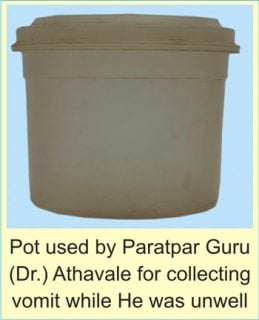 Note 1 : Since this experiment has been conducted for testing auras in the environment, when comparing photos 2 & 3 with the base photo 1, the colour of the pot & table has not been considered.
Note 1 : Since this experiment has been conducted for testing auras in the environment, when comparing photos 2 & 3 with the base photo 1, the colour of the pot & table has not been considered.
Note 2 : While writing about the colours in PIP photos, those depicting negative vibrations are in maroon and those depicting sattvik vibrations are in blue.
Note 3 : When parrot green or white (silvery) that depict superior positive vibrations emerge, sometimes the proportion of yellow, dark green or green that depicts general positive vibrations reduces. This is considered to be a good change, because the general positive vibrations are replaced by more superior positive vibrations.
In 2007, it was observed that the pot used by Paratpar Guru (Dr.) Athavale for collecting vomit when He was unwell started emitting fragrance. This fragrance is still there. This is one example of ‘Divine changes’ in the objects used by Saints.
To scientifically study the effect of this pot on the environment, a test was conducted on 16.11.2016 in Sanatan Ashram, Goa. For the test, ‘PIP’ (Poly-contrast Interference Photography) technology that is suitable for studying the field of aura around objects and people was used. Observations and their description are given here.
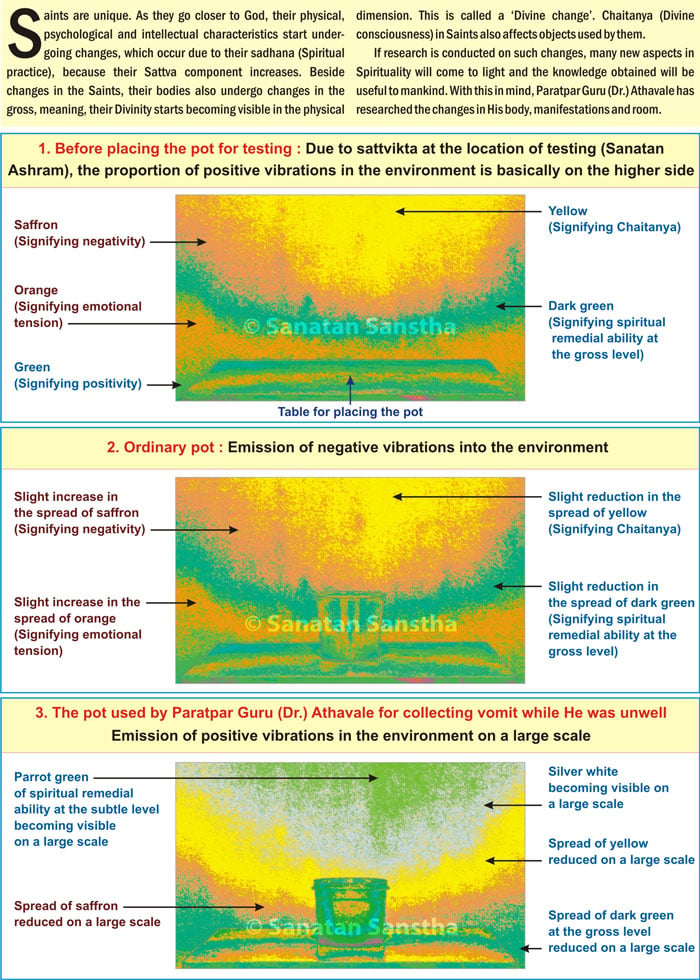
1. Nature of the test
In this test, a photo of the environment was taken before an ordinary pot and the pot used by Paratpar Guru (Dr.) Athavale for collecting His vomit. This is the ‘basic observation’.
Later, photos initially of an ordinary pot and then the pot used by Paratpar Guru (Dr.) Athavale were placed on a table. After a comparative study of both photos, the effect of vibrations emitted by both pots on the environment could be comprehended.
2. Information on components in the scientific test
2A. Ordinary pot
This is the same as the one used by Paratpar Guru (Dr.) Athavale. It was not used earlier by anyone. This pot is used only for conducting the comparative study in ‘PIP’ test.
2B. The pot used by Paratpar Guru (Dr.) Athavale
He was not well for sometime in 2007. He used to vomit often. He could not even walk to the wash basin. He used a plastic pot for collecting the vomit. He stopped using the pot after He recovered. Later, it was observed that the pot was emitting fragrance, which is still there. Saints who are authorities on Spirituality have asserted that this is a ‘Divine fragrance’.
3. Points useful in comprehending the observations
A. Basic observation (Basic aura of the environment)
To study the change in the environment due to a particular component (For example, placing a pot used by Paratpar Guru [Dr.] Athavale in this test), its photo is taken. However, since the environment is constantly changing, its photo, in which the test is to be conducted on the component, is taken before the test.
This is the ‘Base reading’. After the ‘PIP’ photo of the component is compared with the ‘Base reading’ (meaning, the ‘PIP’ photo showing the basic aura of the environment), the change in the environment because of the component is comprehended.
B. The principle underlying increase or reduction in the proportion of colours
This happens in the aura observed after placing the objects when compared with the aura before the objects under test are placed. This increase or reduction is in proportion to the vibrations associated with colours emitted by that object; for example, after the object is placed for the test, if the vibrations of Chaitanya emitted by it are more, the proportion of yellow in the aura increases. Conversely, if vibrations of Chaitanya are not emitted or reduce when comparison with other vibrations, proportion of yellow in the aura reduces. (Tables 4A and 4B should be read with this in mind.)
C. Information on colours of the aura
The colours of the aura observed in the ‘PIP’ photo of the object (or a person) under testing denote particular vibrations in the field of energy of the object. Based on information in the manual made available by the manufacturers of ‘PIP’ computerised technology about each colour in the aura and the experience from observations in the hundreds of tests conducted by ‘Maharshi Adhyatma Vishwavidyalay’, the relationship between the colour and the nature of vibrations is decided. This aspect is depicted in 2nd vertical column of Table 4A.
D. Positive vibrations
Faint pink, parrot green, silver white, yellow, dark green, green, blue and violet denote vibrations on a scale that are spiritually more to lesser beneficial. All these spiritually beneficial vibrations have been called ‘positive vibrations’.
E. Negative vibrations
Grey, pink, orange and saffron denote vibrations on a scale that are spiritually more to lesser distressful. All these spiritually distressful vibrations have been called ‘negative vibrations’.
F. Colours of higher than normal positive
vibrations in ‘PIP’ photo are preferable
When colours of higher positive vibrations such as parrot green or white (silver) are noticed in the ‘PIP’ photo, sometimes the proportion of colours of normal positive vibrations such as yellow, dark green or green reduces. This change is considered desirable because at this time, the space of normal positive vibrations is taken by higher than normal positive vibrations.
G. Characteristics of colours in ‘PIP’ photo
are not related to colours of actual spiritual characteristics
The manufacturers of ‘PIP’ computerised technology have decided saffron and orange colours in ‘PIP’ photos to be indicators of negative vibrations. These have no relationship to the colours of actual spiritual characteristics. (For example, saffron is a symbol of sacrifice and renunciation.)
Note : To decide on the proportion of various colours in the photo, many squares are drawn on the ‘PIP’ photo by the computer programme, akin to graphs. Later, the number of total squares in the photo and a comparative number of squares occupied by the colour in the aura are counted. After converting them into percentages, the proportion of colour in the aura is finalised in percentage.
4. Observations (Read only after looking at ‘PIP’ photos 1,2 & 3)
A. Observation 1 – What do colours
of the aura in ‘PIP’ photo indicate and increase or reduction in their proportion
The comparison of aura of an ordinary pot and the pot used by Paratpar Guru (Dr.) Athavale for collecting His vomit under testing is carried out with basic observation. Please note this and read Table 4A.
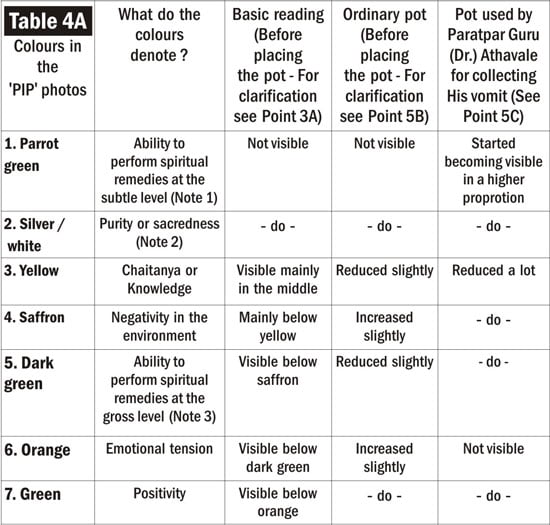
Note 1 : The ability to destroy negative vibrations and enhance positive vibrations on internal and external levels of the component.
Note 2 : The white in the ‘PIP’ photo is not noticed as completely white; similarly, its mention in ‘PIP’ manual is ‘white (silver)’.
Note 3 : The ability to destroy negative vibrations and enhance positive vibrations only on the external levels of the component.
B. Observation 2 – Proportion (%) of each vibration (Colour) in the ‘PIP’ photo (Table 4B)
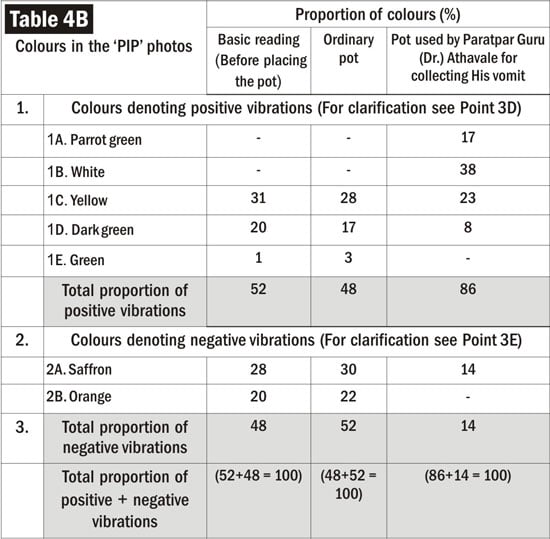
5. Description of observations and deduction
A. Basic observation – The proportion of positive vibrations
is more due to the sattvik environment in Sanatan Ashram
The proportion of negative vibrations emitted by an ordinary premises in Kaliyug is more than that of positive vibrations. Since this testing was conducted in the very sattvik environment of Sanatan Ashram, the proportion of positive vibrations in the basic aura of the environment is more than that of negative vibrations.
B. Negative vibrations were emitted by the ordinary pot
When compared with the base reading, of the colours denoting positive vibrations in the aura of the ordinary pot (such as yellow, dark green) have reduced; whereas, colours denoting negative vibrations (such as saffron and orange) have increased a lot. This is the effect of spiritually distressful vibrations emitting from the ordinary pot. Since the overall proportion of Raja-Tama components has increased in Kaliyug, ordinary objects in the market also have Raja-Tama components to a greater extent. Despite the fact that the ordinary pot looks similar to the pot used by Paratpar Guru (Dr.) Athavale, it has negative vibrations.
C. Since the pot used by Paratpar Guru (Dr.) Athavale for
collecting His vomit is sattvik, positive vibrations are emitted by it to a greater extent
In its aura, the silver white of high purity is seen to a larger extent. Similarly, parrot green of even a higher quality has started to appear, saffron (that indicates negativity) has reduced a lot and orange (that indicates emotional tension) has been eliminated. The reason for this is – due to sattvikta being emitted by Paratpar Guru (Dr.) Athavale, the pot used by Him has also become sattvik to a larger extent. As a result, a higher proportion of positive vibrations is being emitted by the pot.
Saints who are at the highest spiritual level (like Paratpar Guru [Dr.] Athavale) are the source of sattvikta and hence, objects and people who come in their contact also get affected positively. This is the deduction from the test.
– Mr. Rupesh Laxman Redkar (Maharshi Adhyatma Vishwavidyalay, Goa; E-mail : savv.research@gmail.com)
To learn more about ‘PIP’ experiments and methodologies in Scientific Spiritual Research please visit : www.spiritual.university/
Source : Sanatan Prabhat

 The need to change non-sattvik names of some cities such as Bombay, Aurangabad, and re-naming...
The need to change non-sattvik names of some cities such as Bombay, Aurangabad, and re-naming...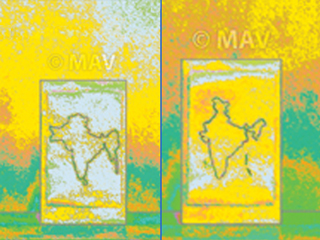 Effect of the map of ‘Akhand Bharat’ and the map of contemporary Bharat on the...
Effect of the map of ‘Akhand Bharat’ and the map of contemporary Bharat on the... Spiritual Puzzle
Spiritual Puzzle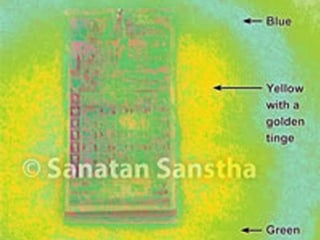 Spiritual importance of ‘Sanatan Almanac’
Spiritual importance of ‘Sanatan Almanac’